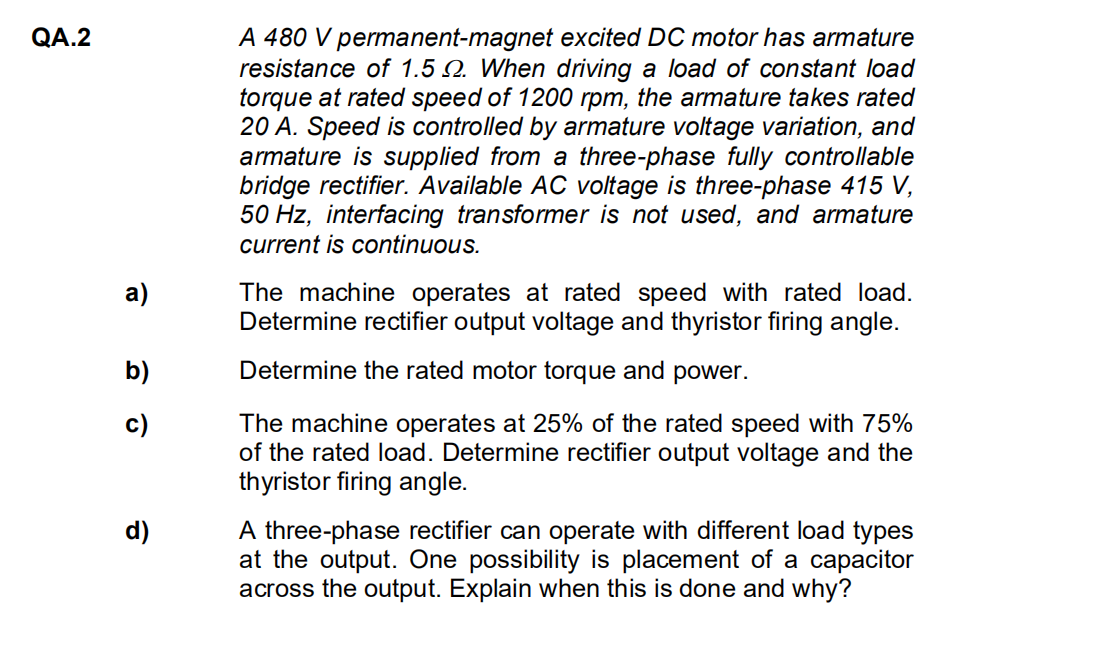A.2 a) b) A 480 V permanent-magnet excited DC motor has armature resistance of 1.5 . When driving a load of constant load torque at rated speed of 1200 rpm, the armature takes rated 20 A. Speed is controlled by armature voltage variation, and armature is supplied from a three-phase fully controllable bridge rectifier. Available AC voltage is three-phase 415 V, 50 Hz, interfacing transformer is not used, and armature current is continuous. The machine operates at rated speed with rated load. Determine rectifier output voltage and thyristor firing angle. Determine the rated motor torque and power. at 250 d with 750/
A.2 a) b) A 480 V permanent-magnet excited DC motor has armature resistance of 1.5 . When driving a load of constant load torque at rated speed of 1200 rpm, the armature takes rated 20 A. Speed is controlled by armature voltage variation, and armature is supplied from a three-phase fully controllable bridge rectifier. Available AC voltage is three-phase 415 V, 50 Hz, interfacing transformer is not used, and armature current is continuous. The machine operates at rated speed with rated load. Determine rectifier output voltage and thyristor firing angle. Determine the rated motor torque and power. at 250 d with 750/
Power System Analysis and Design (MindTap Course List)
6th Edition
ISBN:9781305632134
Author:J. Duncan Glover, Thomas Overbye, Mulukutla S. Sarma
Publisher:J. Duncan Glover, Thomas Overbye, Mulukutla S. Sarma
Chapter12: Power System Controls
Section: Chapter Questions
Problem 12.4P
Related questions
Question

Transcribed Image Text:QA.2
a)
b)
c)
d)
A 480 V permanent-magnet excited DC motor has armature
resistance of 1.5 . When driving a load of constant load
torque at rated speed of 1200 rpm, the armature takes rated
20 A. Speed is controlled by armature voltage variation, and
armature is supplied from a three-phase fully controllable
bridge rectifier. Available AC voltage is three-phase 415 V,
50 Hz, interfacing transformer is not used, and armature
current is continuous.
The machine operates at rated speed with rated load.
Determine rectifier output voltage and thyristor firing angle.
Determine the rated motor torque and power.
The machine operates at 25% of the rated speed with 75%
of the rated load. Determine rectifier output voltage and the
thyristor firing angle.
A three-phase rectifier can operate with different load types
at the output. One possibility is placement of a capacitor
across the output. Explain when this is done and why?
Expert Solution
This question has been solved!
Explore an expertly crafted, step-by-step solution for a thorough understanding of key concepts.
Step by step
Solved in 5 steps with 3 images

Knowledge Booster
Learn more about
Need a deep-dive on the concept behind this application? Look no further. Learn more about this topic, electrical-engineering and related others by exploring similar questions and additional content below.Recommended textbooks for you

Power System Analysis and Design (MindTap Course …
Electrical Engineering
ISBN:
9781305632134
Author:
J. Duncan Glover, Thomas Overbye, Mulukutla S. Sarma
Publisher:
Cengage Learning

Power System Analysis and Design (MindTap Course …
Electrical Engineering
ISBN:
9781305632134
Author:
J. Duncan Glover, Thomas Overbye, Mulukutla S. Sarma
Publisher:
Cengage Learning